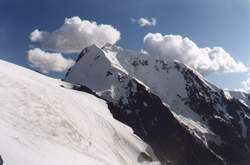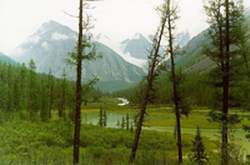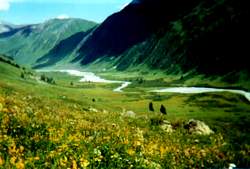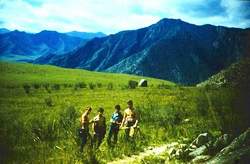 |
|
Sustainable Development in Altay, Xinjiang |
|
 |
|
 Altay locates in the north end of Xinjiang Uygur Autonomous Region, northwest China. Though beautiful in landscape and rich in natural resources, this region has historically been underdeveloped. As China began the West Development Campaign three years ago, Altay has been offered a chance to realize its economic potentiality. Altay locates in the north end of Xinjiang Uygur Autonomous Region, northwest China. Though beautiful in landscape and rich in natural resources, this region has historically been underdeveloped. As China began the West Development Campaign three years ago, Altay has been offered a chance to realize its economic potentiality.
If Xinjiang is compared to the top part of a rooster on a map of China, it is of no exaggeration to say that Altay is a pearl at its tip with much yet to be discovered. Unlike most of the regions in Xinjiang, this area has been blessed with abundant water resources that have nurtured wide rivers, oasis and lush pasturelands. Other natural resources like forests, gold and bronze are also abundant. Altay borders three countries and is home to over 36 ethnic minorities who have made it a place of great cultural diversity. However, the economic boom in this region did not really take off until very recently. An issue that has attracted international concern, development sustainability, has come into the vision of the local government.
“The top priority is sustainability. (Long-term) economic development in Altay largely depends on ecological protection. The cultivation of natural resources should reach a certain scale to ensure a virtuous cycle. This I believe will be good to the sustainable development in this area,” said Zhang Jixun, secretary general of CPC Altay Committee.
It is not so surprising to see mountains with dense forest extending to vast grasslands. But it would be thrilling to experience a view of Gobi deserts, wide rivers and lakes coexisting in the same place. However, this is what we see on our way to the Kanas National Nature Reserve, in the north end of Altay. As tourism is being promoted in this piece of virgin land, Kanas naturally becomes the main hot spot.
It is perhaps too plain describing the water in the Kanas Lake simply as clear. Being a glacier lake, it fascinates people as it changes color in different seasons and even in different times within one day. Kanas has been reputed as Switzerland of the Orient and people who have been there appreciate greatly its tranquility and untouched natural beauty.
 As accessibility of the Kanas Lake has been greatly improved due to sizeable government investment in transportation, the number of tourists has seen a sharp increase.
As accessibility of the Kanas Lake has been greatly improved due to sizeable government investment in transportation, the number of tourists has seen a sharp increase.
The daily capacity of Kanas Lake at present is 2,000 people. Most of the lodges by the lake were built during the past three years. As more tourists pour in, human activities in the Nature Reserve are posing a potential threat to the environment, with pressures accumulating from many directions.
Inspired by practices of other countries, the local government invited environmental and architectural experts from the renowned Tongji University and drew along-term development plan for the region.
Tourism in Kanas is designated as the core industry. Therefore, according to that plan, Jiadengyu Tourist Base will not only function as a comprehensive tourist service with daily capacity reaching 5,000, but also serve as one important center boosting tourism in the neighboring regions. The first stage of the construction that encompasses infrastructure and basic living facilities is expected to complete and be put into use in next August. The demolition work of the existing facilities in the Nature Reserve will start right after that.
After five hours by car southwards we find ourselves by another large lake locally called the Fortune Sea where we discover another initiative unsustainable development. The Fortune Sea, one of the ten largest freshwater lakes in the country, is also a major fish provider in Xinjiang.
 The Fortune Sea in central Altay is part of the Wulungu River, one of the two big river systems in the region. Another one is the Irtys, the only one in the country flowing westwards out of the border to the Arctic Ocean. The Fortune Sea is home to over 22 indigenous types of cold water fish, most of them are unique to this area. As people’s living standards improve, organic fish, though usually higher in price, start to attract higher market demand. It used to be one of the two major fish providers in Xinjiang. But in the past two years, some of the fish population have been experiencing serious reductions in numbers.
The Fortune Sea in central Altay is part of the Wulungu River, one of the two big river systems in the region. Another one is the Irtys, the only one in the country flowing westwards out of the border to the Arctic Ocean. The Fortune Sea is home to over 22 indigenous types of cold water fish, most of them are unique to this area. As people’s living standards improve, organic fish, though usually higher in price, start to attract higher market demand. It used to be one of the two major fish providers in Xinjiang. But in the past two years, some of the fish population have been experiencing serious reductions in numbers.
Several years ago, the Fortune Sea was the second largest fish producer in Xinjiang. But now some fish species are greatly endangered, reflected not only in the dramatic reduction in numbers, but also shrinkage in size. This situation is hindering the economic development of the area. More importantly ecological balance and bio-diversity are also critically challenged.
How to rescue some of the endangered species in the Fortune Sea and make a real fortune for the local people? The solution would be the establishment of a preservation center. This project has been launched by the local government.
The preservation center will be located at the west bank of the central part between two individual lakes. It has good transportation and telecommunications facilities, and is geographically and hydrologically ideal for artificial reproduction. Though this project has been approved by the central government, the Altay municipality is still applying for financial aid and trying to raise overseas capital.
 Tourism and fishing are two industries in Altay with great potential, and important in boosting the regional economic prosperity. Let us hope that ten years later, the water in Kanas Lake is still enchanting, and the diversity of flora and fauna survives human greed.
Tourism and fishing are two industries in Altay with great potential, and important in boosting the regional economic prosperity. Let us hope that ten years later, the water in Kanas Lake is still enchanting, and the diversity of flora and fauna survives human greed.
Source: CCTV-9 China Business Guide
Editor: Yang Yang
|
| - Back - |
|
 |